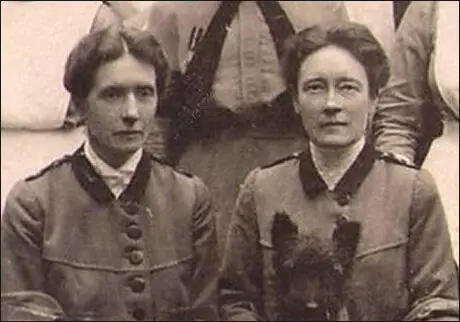Flora Murray

Flora Murray was born on 8th May, 1869. She trained at the London School of Medicine for Women and finished her course at Durham. She then worked in Scotland before returning to London in 1905. She was a medical officer at the Belgrave Hospital for Children and then anaesthetist at the Chelsea Hospital for Women.
In November 1908 she signed a petition sponsored by the National Union of Women's Suffrage Societies. Soon afterwards she joined the Women Social & Political Union. It has been argued by Rebecca Jennings, the author of A Lesbian History of Britain (2007), that Murray was a lesbian and lived for many years with Elsie Inglis.
In 1909 she stood surety for Marion Wallace-Dunlop. She attended several demonstrations where along with her great friend, Louisa Garrett Anderson, she helped treat those members of WSPU who were injured. She was also involved with Anderson and Catherine Pine in running the Notting Hill nursing home that WSPU members went to while recovering from hunger strikes. In 1912 the two women established the Women's Hospital for Children in the Harrow Road. .

On 4th August, 1914, England declared war on Germany. Two days later the NUWSS announced that it was suspending all political activity until the war was over. The leadership of the WSPU began negotiating with the British government. On the 10th August the government announced it was releasing all suffragettes from prison. In return, the WSPU agreed to end their militant activities and help the war effort.

During the First World War a group of wealthy suffragettes, including Janie Allan, decided to fund the Women's Hospital Corps. Murray joined forces with Louisa Garrett Anderson to run a hospital in Claridge Hotel in Paris. Fellow WSPU member, Evelyn Sharp, who visited them in France, remarked: "It was in a way a triumph for the militant movement that these two doctors, who had been prominent members of the W.S.P.U., were the first to break down the prejudice of the British War Office against accepting the services of women surgeons." In February 1915 Anderson and Murray took charge of the Endell Street Military Hospital in London. Anderson was chief surgeon and the hospital treated 26,000 patients before it closed in 1919.
Flora Murray never married and was the constant companion of Louisa Garrett Anderson until her death from rectal carcinoma on 28th July 1923. She was buried in the churchyard at Holy Trinity Church near to her home in Penn, Buckinghamshire.
Primary Sources
(1) Evelyn Sharp, Unfinished Adventure (1933)
I crossed the Channel only once, and that was soon after war broke out, when I spent a week-end in the British hospital run by Dr. Louisa Garrett Anderson, with Dr. Flora Murray, at Wimereux near Boulogne. It was in a way a triumph for the militant movement that these two doctors, who had been prominent members of the W.S.P.U., were the first to break down the prejudice of the British War Office against accepting the services of women surgeons. Under the name of the Women's Hospital Corps they had to work first with the French Red Cross, who felt no such prejudice and allowed them to establish a hospital for wounded soldiers in the Hotel Claridge, Paris. Here, in addition to French wounded, there were some British cases; and when the same women secured permission to open another hospital in the Chateau Mauricien at Wimereux, it was recognised as a voluntary hospital by our own War Office and received only British wounded. This was a prelude to the establishment of the Women's Military Hospital in Endell Street, London, which was under the command of these two doctors and remained open till after the war was over.
(2) Rebecca Jennings, A Lesbian History of Britain (2007)
Other wartime occupations actively encouraged younger unmarried women recruits and a number of women who made a significant contribution to the war effort through their work were in relationships with other women. It is difficult to interpret the precise nature of women's close friendships in the absence of explicit evidence as to how the women themselves viewed them, however. Dr Elsie Inglis, founder of the SWH, had lived with Dr Flora Murray for a number of years in Edinburgh, and Drs Louisa Martindale and Louisa Aldrich-Blake also lived with women. Emily Hamer argues that Evelina Haverfield, founder of a number of women's Voluntary organisations, including the Women's Emergency Corps and the Women's Volunteer Reserves, was a lesbian and lover of the former suffragette Vera 'Jack' Holme. The two women worked closelv with Dr Elsie Inglis in Serbia during the war, and when Haverfield died in 1920, Holme staved in Serbia working as an ambulance and relief lorry driver.

